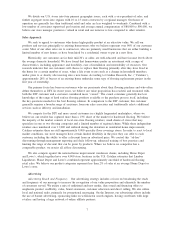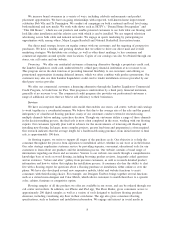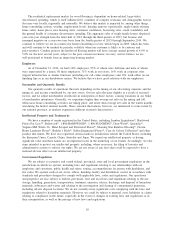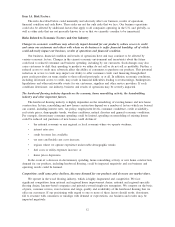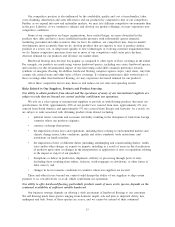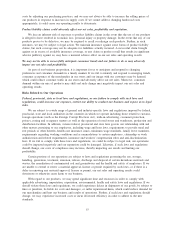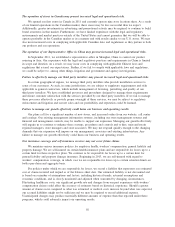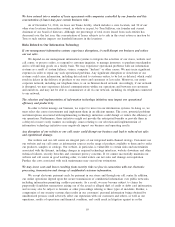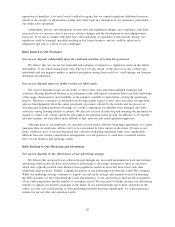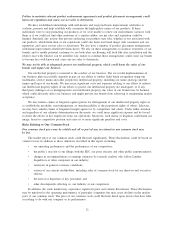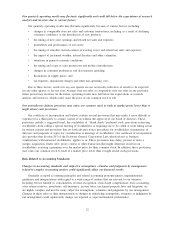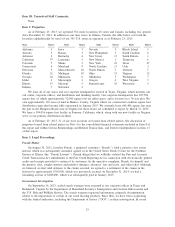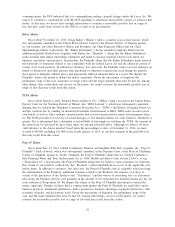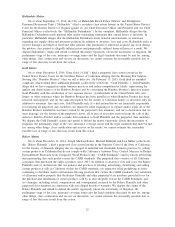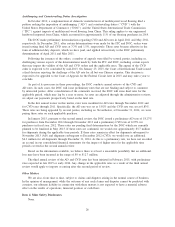Lumber Liquidators 2014 Annual Report Download - page 25
Download and view the complete annual report
Please find page 25 of the 2014 Lumber Liquidators annual report below. You can navigate through the pages in the report by either clicking on the pages listed below, or by using the keyword search tool below to find specific information within the annual report.• future markets and stores may not be successful and, even if we are successful, our average store net
sales and our comparable store net sales may not increase at historical rates.
Finally, our progress in opening new stores from quarter to quarter may occur at an uneven rate, which
may result in quarterly net sales and profit growth falling short of market expectations in some periods.
Our net sales and profit growth could be adversely affected if comparable store net sales are less than we
expect.
While future net sales growth will depend substantially on our plans for new store openings, the level of
comparable store net sales (which represent the change in period-over-period net sales for stores beginning
their thirteenth full month of operation) will also affect our net sales growth and business results. Among
other things, increases in our baseline store volumes and the number of new stores opened in existing markets,
which tend to open at a higher base level of net sales, will impact our comparable store net sales. As a result,
it is possible that we will not achieve our targeted comparable store net sales growth or that the change in
comparable store net sales could be negative. If this were to happen, net sales and profit growth would be
adversely affected.
Increased transportation costs, particularly those relating to the cost of fuel, could harm our results of
operations.
The efficient transportation of our products through our supply chain is a critical component of our
operations. If the cost of fuel or other costs, such as import tariffs, duties and international container rates,
rise, it could result in increases in our cost of sales due to additional transportation charges and in the fees
delivery companies charge us to transport our products to our stores and customers. We may be unable to
increase the price of our products to offset increased transportation charges, which could cause our operating
results to deteriorate.
Business and operation risks exist in connection with our distribution centers.
In 2013, we purchased 110 acres of undeveloped land in Henrico County, Virginia upon which we
constructed a million square foot distribution center. The facility became fully operational in January 2015.
This was our first real estate purchase and is the first distribution center owned by us. The cost of operating
and managing the East Coast distribution center may exceed our expectations and we may not achieve the
benefits that we anticipate from consolidating our East Coast facilities into this East Coast distribution center.
In addition, since early 2014, we have leased and operated a 500,000 square foot distribution center in
Pomona, California, our first distribution center located outside of Virginia. Given the limited period of time
that we have been in the facility, the costs of operating may exceed our expectations and we may not achieve
the benefits that we anticipate. Further, we may face challenges relating to the management of inventory in
separate warehouse facilities located on opposite coasts and the impact of the new East Coast distribution
facility.
If either of these facilities or our inventory held in those locations were damaged or destroyed by fire,
wood infestation or other causes, our distribution processes would be disrupted, which could cause significant
delays in delivery. This could impede our ability to stock our stores and deliver products to our customers,
and cause our net sales and operating results to deteriorate.
Damage, destruction or disruption of our Toano facility could significantly impact our operations and
impede our ability to finish and distribute certain of our products.
Our Toano, Virginia facility serves as our corporate headquarters and, among other things, houses our
primary computer systems, which control our management information and inventory management systems. In
addition, we currently finish approximately 92% of all Bellawood products, as well as small quantities of
certain other products, there. In 2014, Bellawood flooring accounted for approximately 13% of our net sales.
If the Toano facility were damaged or destroyed, it could harm our operations, cause significant lost
production and impact our ability to fulfill customer demand.
17


